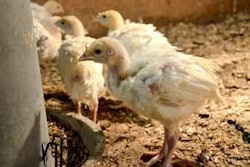Poultry companies have control of only one of two major profitability factors for 2012. Who knows if that is enough.
Coming off the worst year financially for the U.S. poultry industry in 25 to 30 years, what do poultry producers have to look forward to in 2012?
Cautious optimism is the outlook from Mike Donohue of Agri Stats, who spoke at the U.S. Poultry & Egg Association’s Hatchery-Breeder Clinic in late January. Improved prices for chicken and some moderation in feed ingredient costs in recent weeks, he said, have rescued broiler industry profitability for now.
Donohue pointed to chicken breast prices of $1.44 a pound in December of 2011. “That is the best December breast price the industry has seen in a long time,” he said.
“It's not just cutbacks in production that have already occurred but seasonal demand later this year which may set the industry up for an even better first half of 2012,” he said. “I hope this carries over into the latter half of 2012 based on some of the production forecasts that can be made based on breeder placements and inventories.”
Volatility in grain markets makes profit forecasts unreliable
However, producers beware! Volatility in chicken and feed ingredient prices is the watchword going forward. Ongoing volatility in these markets, in fact, makes industry profitability impossible to predict.
“I think the industry is in pretty good shape for the next three to four quarters the way things are going right now, but we are looking at the ongoing volatility in feed ingredient costs,” Donohue said.
Referring to the impossibility of reliably forecasting profitability given the ongoing volatility in grain markets, he quipped, “I’m cautiously, relatively, somewhat less pessimistic than I usually am about this business.”
How to blow up a recovery
Donohue also has concerns about a possible increase in breeder placements. “For the first couple of quarters of this year, if the industry chose to do so, it could ramp up production within a 10-week period of time. The industry could blow apart any recovery in the short term by filling up incubators again,” he said.
For now, however, breeder placements are helping the outlook for profitability. Industry companies are slaughtering breeder flocks at 59 to 60 weeks of age.
“If this holds true for another one or two months, it should bode well for the chicken supply into the second and third quarters of 2012 and even into 2013,” Donohue said.
Younger breeder flocks also are more productive. Hatchability is at 85.5 percent to 86.5 percent in many hatcheries as a result of slaughtering breeder hens at 60 weeks instead of the typical 65 weeks.
Holding chicken production in check
The industry faces two potential challenges to profitability in 2012, according to Donohue – grain prices and broiler production levels.
Corn prices, which were down from $7.50 a bushel in the fall of 2011 to the $7 a bushel range in January 2012, remain unpredictable. “While the ‘new normal’ for corn prices might be $6 a bushel with good growing and harvesting conditions, prices could easily rise to $8.50 a bushel if there are any hiccups in supply this year."
Grain prices befuddle forecasters
Grain prices are in fact the industry’s Achilles heal for profitability projections. Donohue noted that the broiler industry tends to be profitable at production levels of 850 million to 900 million pounds weekly. But even that is a very relative parameter. While the industry’s average price for all pounds sold was up from around 70 cents in 2011 to 82 cents recently, that won’t mean much if corn prices go to $8.50 a bushel.
Consumer demand lost forever?
A longer-term question involves consumer demand for chicken. “Americans, primarily due to the economic challenges over the past four years, have reduced per capita meat consumption by about 18 pounds,” Donohue said. “Five pounds of that reduction is in chicken. It is an open question as to whether the industry will ever get back that lost consumption, even as the economy recovers over the next couple of years.”


















